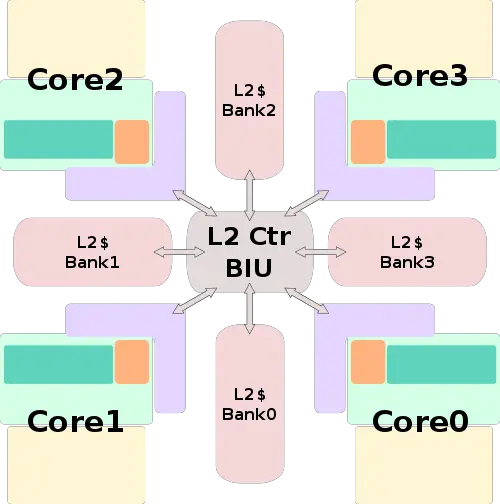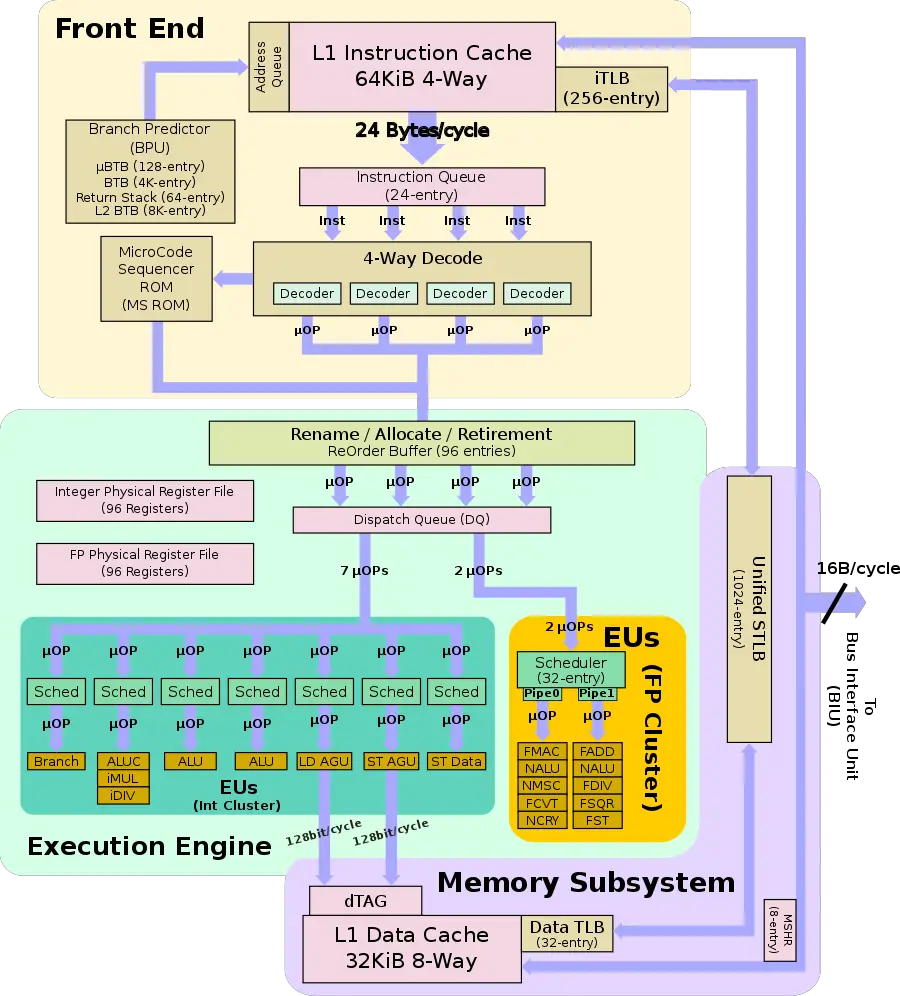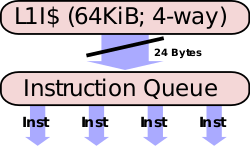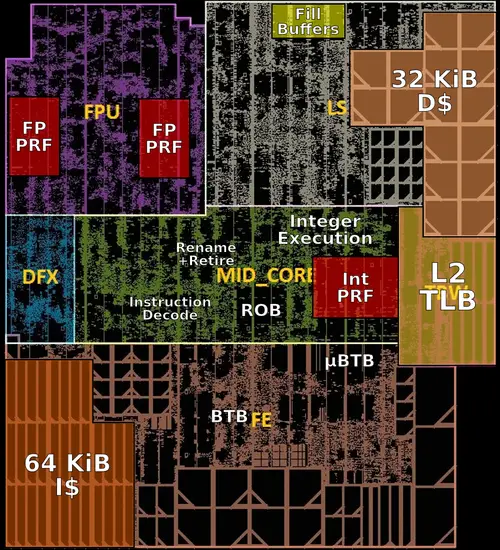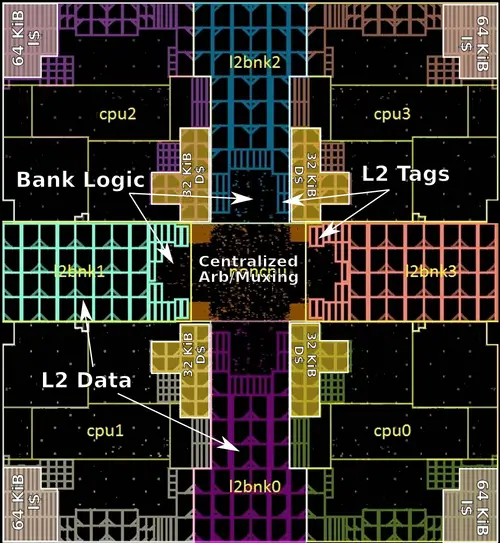| Edit Values | |
| Mongoose 1 µarch | |
| General Info | |
| Arch Type | CPU |
| Designer | Samsung |
| Manufacturer | Samsung |
| Introduction | November 12, 2015 |
| Phase-out | 2017 |
| Process | 14 nm |
| Core Configs | 4 |
| Pipeline | |
| OoOE | Yes |
| Speculative | Yes |
| Reg Renaming | Yes |
| Stages | 14 |
| Decode | 4-way |
| Instructions | |
| ISA | ARMv8 |
| Cache | |
| L1I Cache | 64 KiB/core 4-way set associative |
| L1D Cache | 32 KiB/core 8-way set associative |
| L2 Cache | 2 MiB/cluster 16-way set associative |
| Succession | |
Exynos Mongoose 1 (M1) is an ARM microarchitecture designed by Samsung for their consumer electronics. This was Samsung's first in-house developed high-performance low-power ARM microarchitecture.
Contents
History[edit]
The Mongoose 1 (M1) microarchitecture was Samsung's first in-house design which was done entirely from scratch. A design team was assembled and in roughly 3 years, they've gone from requirements to tape-out. The design was done at Samsung's Austin R&D Center (SARC) which was founded in 2010 for the sole purpose of developing high-performance, low-power, complex CPU and System IPs. A large portion of the design team consists of many ex-AMD Austin engineers as well as ex-IBMers. The Mongoose 1 microarchitecture was led by chief architect Brad Burgess. Previously Burgess was an AMD fellow and the chief architect of AMD's Bobcat microarchitecture, a low-power x86 design.
Process Technology[edit]
M1 was fabricated on Samsung's 14 nm process.
Compiler support[edit]
| Compiler | Arch-Specific | Arch-Favorable |
|---|---|---|
| GCC | -mcpu=exynos-m1 |
-mtune=exynos-m1
|
| LLVM | -mcpu=exynos-m1 |
-mtune=exynos-m1
|
Architecture[edit]
The M1 is Samsung's first in-house design from scratch.
- ARM v8.0
- 2.6 GHz clock frequency
- 2.3 GHz for multi-core workloads
- Sub 3-watt/core
- 14 nm process (FinFET)
- Core
- Advanced branch predictor
- 4-way instruction decode
- Most instructions map to a single µOP, with a few exceptions
- 4-way µOP dispatch and retire
- Out-of-order execution
- Out-of-order load and stores
- Multistride/multistream prefetcher
- Low-latency and low-power caches
Block Diagram[edit]
Core Cluster Overview[edit]
Individual Core[edit]
Memory Hierarchy[edit]
- Cache
- L1I Cache
- 64 KiB, 4-way set associative
- 128 B line size
- per core
- Parity-protected
- 64 KiB, 4-way set associative
- L1D Cache
- 32 KiB, 8-way set associative
- 64 B line size
- per core
- 4 cycles for fastest load-to-use
- 16 B/cycle load bandwidth
- 16 B/cycle store bandwidth
- 32 KiB, 8-way set associative
- L2 Cache
- 2 MiB, 16-way set associative
- 4x banks (512 KiB each)
- Inclusive of L1
- 22 cycles latency
- 16 B/cycle/CPU bandwidth
- 2 MiB, 16-way set associative
- L1I Cache
Mongoose 1 TLB consists of dedicated L1 TLB for instruction cache (ITLB) and another one for data cache (DTLB). Additionally there is a unified L2 TLB (STLB).
- TLBs
- ITLB
- 256-entry
- DTLB
- 32-entry
- STLB
- 1,024-entry
- Per core
- ITLB
- BPU
- 4K-entry main BTB
- 64-entry µBTB
- 64-entry return stack
- 8K-entry L2 BTB
Overview[edit]
Mongoose 1 was an entirely brand new architecture from the ground up that implemented the ARMv8 ISA. The architecture supports both AArch64 and AArch32 including Thumb modes. The architecture is a quad-core design which was intended to be paired with another low-power ARM IP core.
Core[edit]
Pipeline[edit]
The M1 has a speculatively executing out-of-order 4-wide pipeline.
There are two pipeline stages for the branch predictor for generating addresses. There are three cycles for fetching instructions from the instruction cache and delivering them to the instruction queue. There are three decode stages, two renaming stages, and a single dispatch stage.
Both pipes for the execution stage goes through a scheduling cycle followed by a register read cycle. Instruction execution may take a cycle or more depending on the ARM instruction being executed. There is a single cycle for the write back and forwarding. In the case of a load operation, there is an additional translation tag cycle, data cycle, and an alignment and write back cycle.
The last row (in blue) are the 22 cycles latency path for loading data from the level 2 cache.
Front-end[edit]
The front-end is responsible for fetching the correct stream of bytes from the cache based on the traffic flow predictions by the branch predictor and feeding the decoders which decode the instructions into simple signals. The goal of the front-end is the ultimately keep the back-end busy executing as much instructions as possible.
Fetch & pre-decoding[edit]
With the help of the branch predictor, the instructions should already be found in the level 1 instruction cache. The L1I cache is 64 KiB, 4-way set associative and has its own iTLB consisting of 256 entries. Up to 24 bytes are read from it each cycle into the instruction queue which allows them to hide very short branch bubbles. The instruction queue is a slightly more complex component than a simple buffer. The byte stream gets split up into the ARM instructions its made off, including dealing with the various mis-aligned ARM instructions such as in the case of thumb mode.
Branch Predictor[edit]
The M1 has a perceptron branch predictor (Samsung advertises it as a "neural network" predictor) with a couple of perceptrons which can handle two branches per cycle. The unit is capable of indirect predictions as well as loop and stream predictions when it detects those traffic patterns. The unit has a 64-entry µBTB that can be used for caching small tight loops and hot kernels. Additionally, there is a 4K main BTB which covers the entire footprint of the instruction cache and allows for higher accuracy. There is a 64-entry call return stack.
The branch predictor feeds a decoupled instruction address queue which in turn feeds the instruction cache.
Decoding[edit]
From the instruction queue the instructions are sent to decode. Decode is a 4-way decoder which can handle both the ARM AArch64 and AArch32 instructions. Up to four µOPs are decoded and sent to the re-order buffer.
Micro-Sequencer[edit]
For some complex ARM instructions such as the ARMv7 load-store multiples instructions which result in multiple µOPs being emitted, M1 has a side micro-sequencer that will get invoked and emit the appropriate µOPs.
Execution engine[edit]
Renaming & Allocation[edit]
As with the decode, up to four µOPs can be renamed each cycle. For some special cases such as in ARMv7 where four single-precision registers can alias into a single quad register or a pair of doubles, M1 has special logic in the rename area to handle the renaming of those floating point µOPs. For the case of a branch misprediction, M1 has a perform fast map recovery ability as a branch misprediction recovery mechanism.
M1 has a 96-entry reorder buffer which feeds the dispatch queue 4 µOPs per cycle.
Dispatch[edit]
From the dispatch queue, up to 7 µOPs may be issued to the integer cluster and up to 2 µOPs may be issued to the floating point cluster.
Integer cluster[edit]
The dispatch queue feeds the execution units. For integers, there is a 96-entry integer physical register file (roughly 35-36 of them is architected) which means data movement is not necessary. In the integer execution cluster, up to 7 µOPs per cycle may be dispatched to the schedulers. The schedulers are distributed across the various pipes. In total the integer schedulers have 58 entries and those entries are distributed in mixed sizes across the 7 schedulers.
For the first pipe the M1 has a branch resolution unit. The next three pipes have integer ALUs with only the first one capable of also multiplication and division. It's worth pointing out that while all three pipes are capable of execution the typical integer ALU µOPs (i.e., two source µOPs), only ALUC (complex ALU) can also execute three source µOPs. This includes some of the ARMv7 special predicate forms. Generally speaking, most of the simple classes of instructions (e.g., normal add) should be a single cycle while the more complex operations (e.g., add with barrel shift rotate) would be a cycle or two more.
The last three pipes are for the load address adder, store address adder, and store data.
Floating-point cluster[edit]
On the floating point cluster side, up to 2 µOPs may be issued to a unified scheduler which consists of 32 entries. There is a 96-entry floating point (vector) physical register file (roughly 35-36 architected). There are two pipes and both pipes have an integer SIMD unit (NEON). The first 0 features a 5-cycle FMAC and a 4-cycle multiplier while the second pipe incorporates a 3-cycle floating-point adder. Additionally, the first pipe also includes a cryptography unit and a floating point conversion unit while the second pipe incorporates a floating point store unit.
Retirement[edit]
Once execution is complete, µOPs may retire at a rate of up to 4 µOPs per cycle.
Memory subsystem[edit]
The M1 has a 32 KiB 8-way set associative level 1 data cache which is ECC protected. Loads and stores are done fully out of order with all the typical forwarding and light prediction that prevents thrashing. The M1 is capable of a single 128-bit load each cycle and a single 128-bit store each cycle. Note that both operations can be done at the same cycle. The level 1 data cache has a 4-cycle load latency and can support 8 outstanding misses to the L2 hierarchy.
It's worth noting that the dTLB is only 32 entries which is considerably smaller than the 256-entry iTLB. Brad Burgess, Chief CPU Architect for the M1, explained that the reason for this is because the front-end is designed with a lot more room in mind as far as handling a larger TLB capacity natively in its pipeline. It's also physically laid out much further on the floor plan. This allows the L2 TLB to service the dTLB more aggressively.
The M1 has a multi-stride prefetcher which allows it to detect patterns and start the fetching request ahead of execution. While Samsung hasn't gone into too much detail, they noted that there is also some stream/copy optimizations as well which accelerate certain observable traffic patterns.
Core cluster[edit]
The M1 consists of four cores and a shared level 2 cache. Samsung has gone with a four-bank hierarchy with the L2. It is 2 MiB, 16-way set associative and ECC protected broken into 4 banks. Being inclusive of the L1, there are filtering being done for the L1 first. The bank storing the data depends on the address. The exact organization was not detailed. Each bank can return up to 16 bytes per cycle to the cores and has a 22-cycle latency.
Die[edit]
Core Floorplan[edit]
Core Cluster Floorplan[edit]
All M1 Processors[edit]
| List of M1-based Processors | ||||||||
|---|---|---|---|---|---|---|---|---|
| Main processor | Integrated Graphics | |||||||
| Model | Family | Launched | Arch | Cores | Frequency | Turbo | GPU | Frequency |
| 8890 | Exynos | 21 February 2016 | Mongoose 1, Cortex-A53 | 8 | 2.3 GHz 2,300 MHz , 1.6 GHz2,300,000 kHz 1,600 MHz 1,600,000 kHz | 2.6 GHz 2,600 MHz 2,600,000 kHz | Mali-T880 | 600 MHz 0.6 GHz 600,000 KHz |
| Count: 1 | ||||||||
Bibliography[edit]
- Burgess, Brad. "Samsung exynos M1 processor." Hot Chips 28 Symposium (HCS), 2016 IEEE. IEEE, 2016.
- LLVM: lib/Target/AArch64/AArch64SchedExynosM1.td
| codename | Mongoose 1 + |
| core count | 4 + |
| designer | Samsung + |
| first launched | November 12, 2015 + |
| full page name | samsung/microarchitectures/m1 + |
| instance of | microarchitecture + |
| instruction set architecture | ARMv8 + |
| manufacturer | Samsung + |
| microarchitecture type | CPU + |
| name | Mongoose 1 + |
| phase-out | 2017 + |
| pipeline stages | 14 + |
| process | 14 nm (0.014 μm, 1.4e-5 mm) + |
